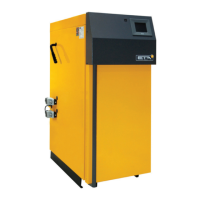Parallel or serial connection
between several buffers
When there are several buffers, normally the parallel
connection (top with top and bottom with bottom)
is the better solution.
With a parallel connection, the entire buffer volume
is available to installed heat exchangers such as solar
heat exchangers or internal water heat exchangers
and suspended hot water tanks.
(Return)
Flow
Solar return
Solar flow
If two buffer storage tanks of different dimensions
are connected in parallel, then the flow must be
connected to the higher one or the lower one must
be raised so that the upper connection can be
horizontal.
A serial connection between two buffers has no
advantages over a parallel connection; if anything
it is a disadvantage. For example, a suspended
hot water tank can get no heat from the second
buffer or an internal heat exchanger cannot heat
on both buffers. For this reason, with serial buffers
one should connect a solar supply using either
heat exchangers in both buffers or better with an
external heat exchanger.
With rare exceptions, the use of the serial
connection (buffer 2 top and buffer 1 bottom
connected) is limited to overcoming spatial obstacles
in the given installation situation. Only a serial
connection is possible if the passage to a door
needs to be kept free or for large distances between
buffers.
Tichelmann connection for higher outputs
For parallel connection with one-sided connection,
the volume of the second buffer is integrated via
thermosiphon principle. The exchange between
the two tanks is driven only by gravity and limited
by the hydraulic resistance of the junctions, so
for medium outputs a Tichelmann connection is
required.
With a 6/4" connection, a maximum of 5,500 l/h
at 0.25 mH
2
O pressure loss is possible (for flow and
return connections together). This corresponds to
130 kW at a spread of 20°C. Therefore, for higher
outputs external piping, either symmetric or with
Tichelmann connection, is needed.
With more than two tanks, external piping with
Tichelmann connection is also needed to fill and
drain all tanks uniformly.
Parallel buffer storage
tanks
Buffer connections
5/4" DN32
Buffer connections
6/4"
DN40
one-sided connection
up to 25 kW
boiler output
up to 40 kW
boiler output
internal
Tichelmann connection
up to 80 kW
boiler output
up to 130 kW
boiler output
Symmetric connection
for more than
80 kW boiler output
for more than
130 kW boiler output
external piping with
Tichelmann connection
for more than
80 kW boiler output
for more than
130 kW boiler output
and/or
for more than two buffer storage tanks
Flow
Return
Flow
Return
Flow
Return
Maximum 2 buffers
Maximum 2 buffers
Flow
Return
Maximum 2 buffers
Buffer storage tanks demand softened water
If buffer storage tanks are installed in a heating
system, the system must be filled with softened
water. Around 0.25 kg of limescale will precipitate
from a cubic metre of water with 15° of German
hardness.

